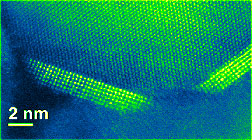- Number 402 |
- December 2, 2013
Maximizing energy gains from tiny nanoparticles

Transmission electron micrograph of
cerium oxide nanoparticles (bright angular
"slashes") supported on a titania substrate
a potential catalyst for energy-
transformation reactions.
Sometimes big change comes from small beginnings. That’s especially true in the research of Anatoly Frenkel, a professor of physics at Yeshiva University, who is working with materials scientist Eric Stach and others at DOE's Brookhaven Lab to reinvent the way we use and produce energy by unlocking the potential of nanoparticles. Their aim is to develop a new “micro-reactor” to study how nanoparticles behave in catalysts—the “kick-starters” of chemical reactions that convert fuels to useable forms of energy and transform raw materials to industrial products
The new micro-reactor will employ multiple techniques including microscopy, spectroscopy, and diffraction at Brookhaven’s National Synchrotron Light Source (NSLS), the soon-to-be-completed NSLS-II, and the Center for Functional Nanomaterials (CFN) to examine different properties of catalysts simultaneously under operating conditions. By keeping particles in the same structural and dynamic state under the same reaction conditions, the micro-reactor will give scientists a much better sense of how they function. The work could point to ways to improve catalyst designs and yield big gains in energy efficiency and cost savings for industrial processes.
The collaboration also offers opportunities for students to experience the challenges of research, giving them access to the world-class tools at Brookhaven. Frenkel’s undergraduate students at Yeshiva University’s Stern College for Women help with measurements, data analysis, and interpretation, and many have accompanied him to Brookhaven to assist in his work using NSLS and other cutting-edge instruments.
“I’m giving them firsthand experience about what a researcher’s life is like early on as they conduct first-rate research,” said Frenkel. “This experience opens doors to any field they want to be in.”
Full story: http://www.bnl.gov/newsroom/news.php?a=24446.
[Karen McNulty Walsh, 631.344.8350,
kmcnulty@bnl.gov]
